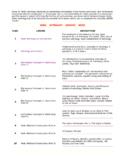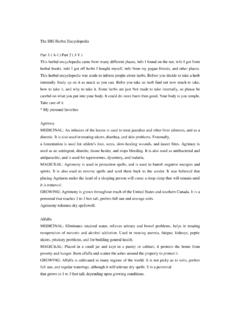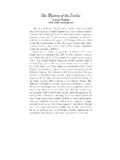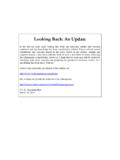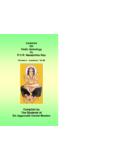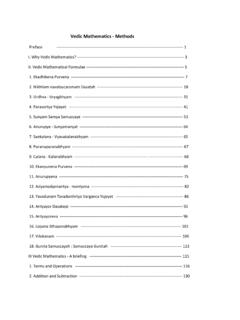Transcription of Vedic Maths Tutorial (interactive) - Hindu Temple of ...
1 | Site | Educational Material | Resources | Community | Other Material | Utilities Vedic Maths TutorialVedic Maths is based on sixteen sutras or principles. These principles are general in nature and can be applied in many ways. In practice many applications of the sutras may be learned and combined to solve actual problems. These tutorials will give examples of simple applications of the sutras, to give a feel for how the Vedic Maths system works. These tutorials do not attempt to teach the systematic use of the sutras. For more advanced applications and a more complete coverage of the basic uses of the sutras, we recommend you study one of the texts The following tutorials are based on examples and exercises given in the book 'Fun with figures' by Kenneth Williams, which is a fun introduction some of the applications of the sutras for you are having problems using the tutorials then you could always read the instructions.
2 Tutorial 1 Tutorial 2 Tutorial 3 Tutorial 4 Tutorial 5 Tutorial 6 Tutorial 7 Tutorial 1 Use the formula ALL FROM 9 AND THE LAST FROM 10 to perform instant For example 1000 - 357 = 643 We simply take each figure in 357 from 9 and the last figure from the answer is 1000 - 357 = 643 And thats all there is to it!This always works for subtractions from numbers consisting of a 1 followed by noughts: 100; 1000; 10,000 Similarly 10,000 - 1049 = 8951 l For 1000 - 83, in which we have more zeros than figures in the numbers being subtracted, we simply suppose 83 is 083. So 1000 - 83 becomes 1000 - 083 = 917 Vedic Maths Tutorial (interactive) (1 of 12)2/10/2004 8:36:53 PMVedic Maths Tutorial (interactive)Try some yourself:1) 1000 - 777 = 2) 1000 - 283= 3) 1000 - 505= 4) 10,000 - 2345= 5) 10000 - 9876= 6) 10,000 - 1101= 7) 100 - 57= 8) 1000 - 57= 9) 10,000 - 321= 10) 10,000 - 38= Total Correct = Return to IndexTutorial 2 Using VERTICALLY AND CROSSWISE you do not need to the multiplication tables beyond 5 X Suppose you need 8 x 7 8 is 2 below 10 and 7 is 3 below of it like this:The answer is diagram below shows how you get subtract crosswise 8-3 or 7 - 2 to get 5,the first figure of the you multiply vertically: 2 x 3 to get 6,the last figure of the 's all you do: (2 of 12)2/10/2004 8:36.
3 53 PMVedic Maths Tutorial (interactive)See how far the numbers are below 10, subtract onenumber's deficiency from the other number, andmultiply the deficiencies 7 x 6 = 42 Here there is a carry: the 1 in the 12 goes over to make 3 into 4. Multply These:1) 8 8 x 2) 9 7 x 3) 8 9 x 4) 7 7 x 5) 9 9 x 6) 6 6 x Total Correct = Here's how to use VERTICALLY AND CROSSWISE for multiplying numbers close to Suppose you want to multiply 88 by 98. Not easy,you might think. But withVERTICALLY AND CROSSWISE you can givethe answer immediately, using the same methodas 88 and 98 are close to is 12 below 100 and 98 is 2 below can imagine the sum set out like this: As before the 86 comes fromsubtracting crosswise: 88 - 2 = 86(or 98 - 12 = 86: you can subtracteither way, you will always getthe same answer).
4 And the 24 in the answer isjust 12 x 2: you multiply 88 x 98 = 8624 This is so easy it is just mental some: (3 of 12)2/10/2004 8:36:53 PMVedic Maths Tutorial (interactive)1) 87 98 x 2) 88 97 x 3) 77 98 x 4) 93 96 x 5) 94 92 x 6) 64 99 7) 98 97 x Total Correct = Multiplying numbers just over 103 x 104 = 10712 The answer is in two parts: 107 and 12,107 is just 103 + 4 (or 104 + 3),and 12 is just 3 x Similarly 107 x 106 = 11342 107 + 6 = 113 and 7 x 6 = 42 Again, just for mental arithmeticTry a few:1) 102 x 107 = 1) 106 x 103 = 1) 104 x 104 = 4) 109 x 108 = 5) 101 x123 = 6) 103 x102 = Total Correct = Return to IndexTutorial 3 The easy way to add and subtract VERTICALLY AND CROSSWISE to write the answer straight down!l Multiply crosswise and add to get the top of the answer:2 x 5 = 10 and 1 x 3 = 3.
5 Then 10 + 3 = bottom of the fraction is just 3 x 5 = (4 of 12)2/10/2004 8:36:53 PMVedic Maths Tutorial (interactive)You multiply the bottom number : l Subtracting is just as easy: multiply crosswise as before, but the subtract:l Try a few: Total Correct = Return to Index Tutorial 4A quick way to square numbers that end in 5 using the formula BY ONE MORE THAN THE ONE 752 = 5625 752 means 75 x answer is in two parts: 56 and last part is always first part is the first number, 7, multiplied by the number "one more", which is 8:so 7 x 8 = 56 (5 of 12)2/10/2004 8:36:53 PMVedic Maths Tutorial (interactive) l Similarly 852 = 7225 because 8 x 9 = 72. Try these:1) 452 = 2) 652 = 3) 952 = 4) 352 = 5) 152 = Total Correct = Method for multiplying numbers where the first figures are the same and the last figures add up to 32 x 38 = 1216 Both numbers here start with 3 and the lastfigures (2 and 8) add up to we just multiply 3 by 4 (the next number up)to get 12 for the first part of the we multiply the last figures: 2 x 8 = 16 toget the last part of the :l And 81 x 89 = 7209 We put 09 since we need two figures as in all the other some:1) 43 x 47 = 2) 24 x 26 = 3) 62 x 68 = (6 of 12)2/10/2004 8:36.
6 54 PMVedic Maths Tutorial (interactive)4) 17 x 13 = 5) 59 x 51 = 6) 77 x 73 = Total Correct = Return to Index Tutorial 5An elegant way of multiplying numbers using a simple 21 x 23 = 483 This is normally called long multiplication butactually the answer can be written straight downusing the VERTICALLY AND first put, or imagine, 23 below 21:There are 3 steps:a) Multiply vertically on the left: 2 x 2 = 4. This gives the first figure of the ) Multiply crosswise and add: 2 x 3 + 1 x 2 = 8 This gives the middle ) Multiply vertically on the right: 1 x 3 = 3 This gives the last figure of the thats all there is to Similarly 61 x 31 = 1891l 6 x 3 = 18; 6 x 1 + 1 x 3 = 9; 1 x 1 = 1 Try these, just write down the answer: (7 of 12)2/10/2004 8:36:54 PMVedic Maths Tutorial (interactive)1) 14 21 x 2) 22 31 x 3) 21 31 x 4) 21 22 x 5) 32 21 x Total Correct = Multiply any 2-figure numbers together by mere mental arithmetic!
7 If you want 21 stamps at 26 pence each you caneasily find the total price in your were no carries in the method given , there only involve one small extra 21 x 26 = 546 The method is the same as aboveexcept that we get a 2-figure number, 14, in themiddle step, so the 1 is carried over to the left(4 becomes 5).So 21 stamps cost a few:1) 21 47 x 2) 23 43 x 3) 32 53 x 4) 42 32 x 5) 71 72 x Total Correct = l 33 x 44 = 1452 There may be more than one carry in a sum:Vertically on the left we get gives us 24, so we carry 2 to the leftand mentally get vertically on the right we get 12 and the 1here is carried over to the 144 to make (8 of 12)2/10/2004 8:36:54 PMVedic Maths Tutorial (interactive)6) 32 56 x 7) 32 54 x 8) 31 72 x 9) 44 53 x 10) 54 64 x Total Correct = Any two numbers, no matter how big, can bemultiplied in one line by this method.
8 Return to Index Tutorial 6 Multiplying a number by multiply any 2-figure number by 11 we just putthe total of the two figures between the 2 26 x 11 = 286 Notice that the outer figures in 286 are the 26being the middle figure is just 2 and 6 added So 72 x 11 = 792 Multiply by 11:1) 43 = 2) 81 = 3) 15 = 4) 44 = 5) 11 = Total Correct = l 77 x 11 = 847 This involves a carry figure because 7 + 7 = 14we get 77 x 11 = 7147 = by 11:1) 88 = (9 of 12)2/10/2004 8:36:54 PMVedic Maths Tutorial (interactive)2) 84 = 3) 48 = 4) 73 = 5) 56 = Total Correct = l 234 x 11 = 2574 We put the 2 and the 4 at the add the first pair 2 + 3 = we add the last pair: 3 + 4 = by 11:1) 151 = 2) 527 = 3) 333 = 4) 714 = 5) 909 = Total Correct = Return to Index Tutorial 7 Method for diving by 23 / 9 = 2 remainder 5 The first figure of 23 is 2, and this is the remainder is just 2 and 3 added up!
9 L 43 / 9 = 4 remainder 7 The first figure 4 is the answerand 4 + 3 = 7 is the remainder - could it be easier?Divide by 9:1) 61 = remainder (10 of 12)2/10/2004 8:36:54 PMVedic Maths Tutorial (interactive)2) 33 = remainder 3) 44 = remainder 4) 53 = remainder 5) 80 = remainder Total Correct = l 134 / 9 = 14 remainder 8 The answer consists of 1,4 and is just the first figure of is the total of the first two figures 1+ 3 = 4,and 8 is the total of all three figures 1+ 3 + 4 = by 9:6) 232 = remainder 7) 151 = remainder 8) 303 = remainder 9) 212 = remainder 10) 2121 = remainder Total Correct = l 842 / 9 = 812 remainder 14 = 92 remainder 14 Actually a remainder of 9 or more is not usuallypermitted because we are trying to find howmany 9's there are in the remainder, 14 has one more 9 with 5left over the final answer will be 93 remainder 5 Divide these by 9.
10 1) 771 = remainder 2) 942 = remainder 3) 565 = remainder 4) 555 = remainder 5) 777 = remainder (11 of 12)2/10/2004 8:36:54 PMVedic Maths Tutorial (interactive)6) 2382 = remainder 7) 7070 = remainder Total Correct = Return to Index Instructionsfor using the tutorialsEach Tutorial has test sections comprising of several questions each. Next to each question is a box (field) into which you can enter the answer to the question. Select the first question in each test with the mouse to start a test. Enter the answer for the question using the numeric keys on the keyboard. To move to the answer field of the next question in the test, press the 'TAB' key. Moving to the next question, will cause the answer you entered to be checked, the following will be displayed depending on how you answered the question :-CorrectWrongAnswer has more than one part (such as fractions and those answers with remainders).
